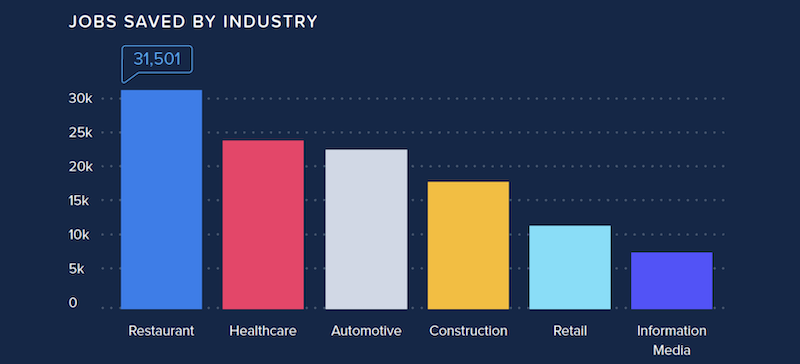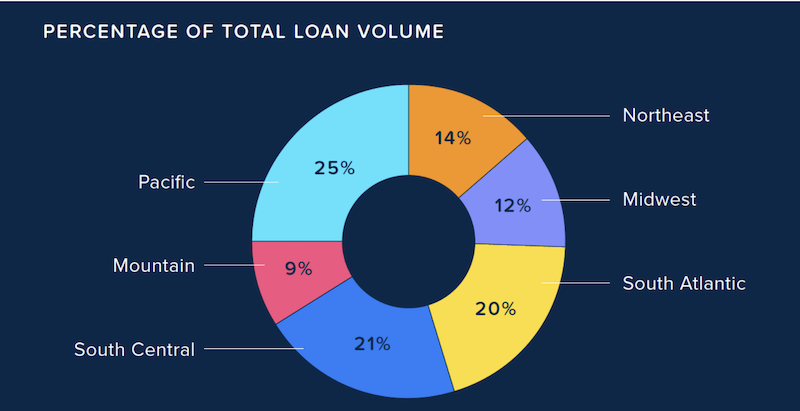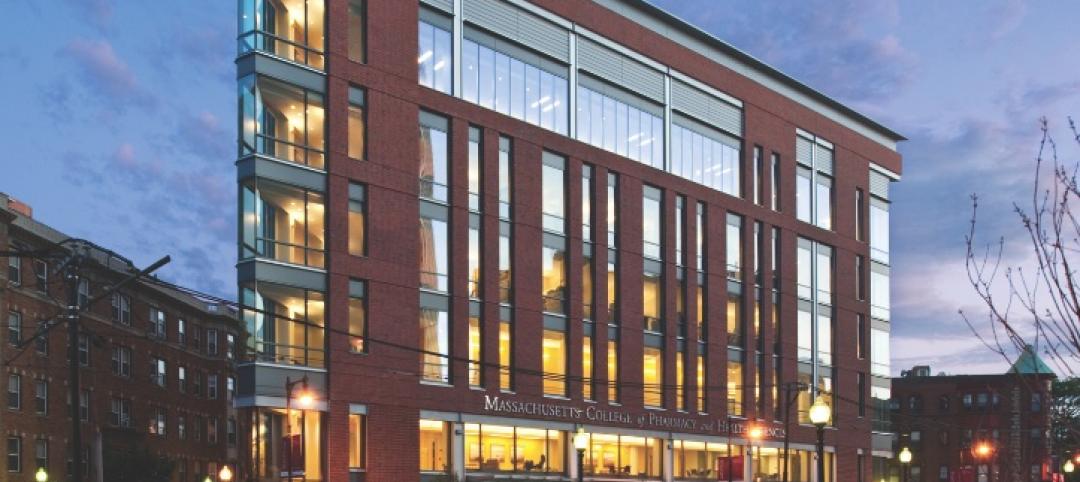Earlier this week the Small Business Administration and U.S. Treasury Department released a list of recipients from the government’s Paycheck Protection Program (PPP), which so far has allocated $521 billion of the $670 billion approved by Congress under the CARES Act to nearly 659,000 borrowers. The Trump Administration claims that this program has supported 51 million jobs, roughly 84% of whom work for small businesses.
At presstime, SBA hadn't released exactly how much each entity was approved to borrow. And some recipients—like retail and fast-food chains, millionaire rock bands, and a business venture led by NFL quarterback Tom Brady, who earned $23 million last year—have raised questions about the program’s purpose and vetting process.
But according to Lendio, a small business marketplace, construction led all industries in total volume among the 100,000 PPP loans totaling $8 billion that Lendio facilitated in partnership with 300 lenders between April 3 and June 30.
FIRST LOAN ROUND LEFT SMALL BUSINESSES STRANDED

The PPP program allowed businesses in many sectors to keep their workers employed even if they were shut down by the coronavirus.
Lendio and its partners tapped into the $350 billion in relief lending that Congress approved in early May, which went primarily to small businesses and small proprietorships.
When Congress approved the first round of PPP loans, its intention was to provide a life raft to businesses forced to close because of the coronavirus pandemic. Borrowers could receive up to 2.5 times their companies’ monthly payrolls, much of which would be forgiven if they keep their workers employed.
However, small businesses struggled to access the first round of PPP loans, totaling $349 billion, which lasted only two weeks and was gobbled up by relatively few businesses. For the second round, Congress earmarked $30 billion specifically for community banks so they wouldn’t have to compete with larger lenders.
The demand was certainly pressing. Lendio points out that prior to participating in the PPP, it had facilitated $2 billion in business loans since its inception in 2011.
The average PPP loan on the Lendio platform is $73,000, versus the national average of $107,000. During the PPP, 30% of the loans that Lendio facilitated went to businesses in urban areas, 28% in the suburbs, and 39% in rural communities. The Pacific and South Atlantic regions of the country accounted for 45% of Lendio’s PPP loans.
LENDIO FACILITATES $182 MILLION IN LOANS TO CONSTRUCTION BORROWERS

About 45% of the PPP loans that Lendio facilitated were to businesses in the Pacific and South Atlantic regions of the U.S.
Of the loans facilitated by Lendio, just under $181.7 million went to businesses in the construction industry, the highest total volume for any sector. Construction was followed by healthcare, restaurants, information media, manufacturing, and retail.
The average loan for construction borrowers was just under $100,000, which ranked fourth by sector, with manufacturing topping this list at $145,568 per loan average.
Lendio estimates that construction borrowers saved 17,500 jobs as a result of the PPP, behind restaurants (31,501 jobs saved), healthcare, and automotive.
ARE MORE LOANS IMMINENT?
Right now, Congress and the White House are debating whether more stimulus is needed, as the coronavirus continues to spread in several areas of the country, with nearly 3.1 confirmed cases of COVID-19 and 133,000 deaths in the U.S., and with hospitalizations rising in 22 states. Some states, cities and towns are reconsidering their plans for reopening their economies.
“Unfortunately, the challenges for small business owners do not end when they receive a PPP loan and great economic uncertainty remains,” writes Lendio. It notes that business owners are now navigating the loan forgiveness process, and others continue to seek financial assistance while operating on thin margins. “As demonstrated throughout the program to date, the need for relief funding is unprecedented and will likely continue as small business owners seek to reopen and rebuild in the coming months.”
Related Stories
| Mar 7, 2011
Sika Sarnafil announces 2010 roofing Contractor Project of the Year winners
Sika Sarnafil announced winners of its 2010 Contractor Project of the Year Competition. Twelve contractors were recognized for outstanding workmanship in completing a project using a Sika Sarnafil thermoplastic membrane for roofing or waterproofing applications. A winner and two finalists were chosen from each of four different categories: Low Slope, Steep Slope, Waterproofing and Sustainability.
| Mar 3, 2011
Webcor Builders and Shangri-La Construction form partnership
Webcor Builders and Shangri-La Construction announced today that the two general contractors have formed an exclusive partnership to pursue and provide general contracting and construction management services in select western states including California, Arizona, Nevada and Texas. The partnership, which will be named Webcor LA, will pursue construction projects across aviation, commercial real estate and tenant improvement, hospitality, institutional, healthcare, industrial, public works, and multi-family categories.
| Mar 2, 2011
Design professionals grow leery of green promises
Legal claims over sustainability promises vs. performance of certified green buildings are beginning to mount—and so are warnings to A/E/P and environmental consulting firms, according to a ZweigWhite report.
| Mar 2, 2011
How skyscrapers can save the city
Besides making cities more affordable and architecturally interesting, tall buildings are greener than sprawl, and they foster social capital and creativity. Yet some urban planners and preservationists seem to have a misplaced fear of heights that yields damaging restrictions on how tall a building can be. From New York to Paris to Mumbai, there’s a powerful case for building up, not out.
| Mar 1, 2011
How to make rentals more attractive as the American dream evolves, adapts
Roger K. Lewis, architect and professor emeritus of architecture at the University of Maryland, writes in the Washington Post about the rising market demand for rental housing and how Building Teams can make these properties a desirable choice for consumer, not just an economically prudent and necessary one.
| Feb 24, 2011
Lending revives stalled projects
An influx of fresh capital into U.S. commercial real estate is bringing some long-stalled development projects back to life and launching new construction of apartments, office buildings and shopping centers, according to a Wall Street Journal article.
| Feb 23, 2011
London 2012: What Olympic Park looks like today
London 2012 released a series of aerial images that show progress at Olympic Park, including a completed roof on the stadium (where seats are already installed), tile work at the aquatic centre, and structural work complete on more than a quarter of residential projects at Olympic Village.
| Feb 23, 2011
Call for Entries: 2011 Building Team Awards, Deadline: March 25, 2011
The 14th Annual Building Team Awards recognizes newly built projects that exhibit architectural and construction excellence—and best exemplify the collaboration of the Building Team, including the owner, architect, engineer, and contractor.
| Feb 23, 2011
Green building on the chopping block in House spending measure
Bryan Howard, Legislative Director of the U.S. Green Building Council, blogs about proposed GOP budget cuts that could impact green building in the commercial sector.
| Feb 22, 2011
LEED Volume Program celebrates its 500th certified Pilot Project
More than 500 building projects have certified through the LEED Volume Program since the pilot launched in 2006, according to the U.S. Green Building Council. The LEED Volume Program streamlines the certification process for high-volume property owners and managers, from commercial real estate firms, national retailers and hospitality providers, to local, state and federal governments.











